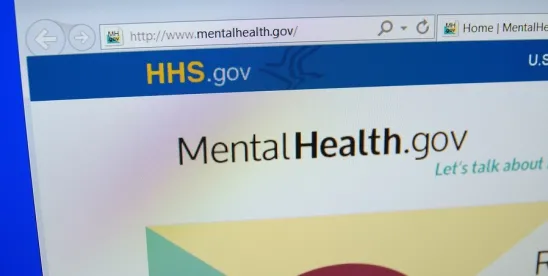On September 23, 2024, the U.S. Departments of Health and Human Services, Labor, and the Treasury (collectively, the “Departments”) issued a final rule (“Final Rule”) implementing amendments made by the Consolidated Appropriations Act of 2021 to the Mental Health Parity and Addiction Equity Act (MHPAEA).
As we previously reported, the Departments published a proposed rule on August 3, 2023 (“Proposed Rule”), that, among other provisions, required documentation of comparative analyses for non-quantitative treatment limits (NQTLs), which are non-financial restrictions on health care benefits that can limit the length or scope of treatment. The Final Rule is largely similar to the Proposed Rule but includes certain changes that employers should understand.[1]
Key Changes Under the Final Rule Affecting Employers
The following three aspects of the Final Rule are noteworthy for employers:
- Elimination of Quantitative Testing for Non-Quantitative Treatment Limits: The Final Rule withdraws the proposed application of quantitative thresholds to define the “predominant” level of an NQTL that applied to “substantially all” medical/surgical (M/S) benefits in a classification. This proposal would have applied a mathematical test for NQTLs that was comparable to the test that is applied to financial requirements and quantitative treatment limits. Public comments pointed out the confusion that would result from the proposed design and exceptions to this test as applied to NQTLs, the potentially sweeping consequences, and the arguably tenuous statutory authority. In response, the Final Rule eliminates the proposed mathematical interpretation of the statutory requirement.
Instead, the Final Rule concludes that the existing NQTL test (hinging on the requirement for NQTLs to be “comparable” and “applied no more stringently” to mental health and substance use disorder (MH/SUD) benefits relative to M/S benefits) satisfies the statutory requirement for treatment limits on MH/SUD benefits to be no more stringent than the predominant limit that applies to substantially all M/S benefits.
- Application of MHPAEA to Intellectual and Developmental Disabilities, Including Autism Spectrum Disorder: The Final Rule contains the proposed requirement to stipulate that plans must define “MH/SUD benefits” to include all covered conditions that fall under any of the diagnostic categories listed in the mental, behavioral, and neurodevelopmental disorders chapter of the current version of the International Classification of Diseases or the Diagnostic and Statistical Manual of Mental Disorders. Notably, this includes intellectual and developmental disabilities featured in that chapter, including autism spectrum disorder. In addition to clarifying that coverage for these intellectual and developmental disabilities must meet the MHPAEA requirements, the Final Rule makes clear that plans must cover “meaningful benefits” in every classification for every covered condition. On account of previous ambiguity about whether intellectual and developmental disorders should be considered “mental health conditions” for MHPAEA compliance purposes, many health plans sharply limit coverage for these conditions. In particular, many commercial health plans exclude coverage for applied behavior analysis (ABA) for autism spectrum disorder. However, the Final Rule indicates that plans that exclude coverage for ABA would be unlikely to satisfy the “meaningful benefits” requirement. Employers should, therefore, review the current scope of benefits covered for intellectual and developmental disabilities to ensure that (i) such coverage meets the “meaningful benefits” requirement and (ii) quantitative treatment limits and NQTLs that are applied to such benefits comply with the applicable tests under MHPAEA.
- Fiduciary Liability: The Proposed Rule required at least one named fiduciary to review the comparative analyses and certify whether they found the analyses to comply with the applicable content requirements. Under the Final Rule, this was revised to require a certification that one or more named fiduciaries have “engaged in a prudent process to select one or more qualified service providers to perform and document a comparative analysis… and [have] satisfied their duty to monitor those service providers as required under part 4 of [the Employee Retirement Income Security Act (ERISA)] with respect to the performance and documentation of such comparative analysis.” The preamble further clarifies that the U.S. Department of Labor expects that a plan fiduciary making such a certification will, at a minimum:
- review the comparative analyses that are prepared by or on behalf of the plan;
- ask questions about the analyses and discuss them with service providers, as necessary, to understand the findings and conclusions documented in the analysis; and
- require their service providers to provide assurance that, to the best of their ability, each NQTL and associated comparative analysis complies with the requirements of MHPAEA and the comparative analysis requirements.
The compliance threshold for the duty to “ask questions” and “understand the findings and conclusions” may be unclear, particularly given that the statute and Final Rule expressly place the full compliance obligation for all aspects of MHPAEA on the health plan itself. However, it seems clear that the U.S. Department of Labor intends for the Final Rule to shift the emphasis of the compliance requirements for health plan sponsors to focus on prudent processes to select and monitor their contracted service providers. In turn, the rules emphasize the role of the service provider for possessing the requisite technical knowledge necessary for ensuring that comparative analyses comply with all aspects of the highly complex and nuanced requirements of the Final Rule. Many employers will consider this a welcome change, as it aligns the named fiduciary’s certification requirements more closely with duties they already have under ERISA when it comes to selecting and monitoring service providers.
Applicability Dates
The Departments provide a delayed applicability date for three aspects of the Final Rule: a new requirement to cover “meaningful benefits” for each covered MH/SUD condition in each benefit classification, a new prohibition on discriminatory factors and evidentiary standards for NQTLs, and new outcomes data evaluation requirements for comparative analyses. Compliance with these three sets of requirements is mandatory by the first day of the first plan year starting on or after January 1, 2026.
However, the applicability date for most of the key new substantive requirements in the Final Rule is the first day of the first plan year, starting on or after January 1, 2025. This includes almost all aspects of the new requirements for comparative analyses for NQTLs, the new definitions for “mental health benefits” and “substance use disorder benefits,” and the new plan fiduciary certification requirement.
What Employers Should Do Now
The Final Rule significantly expands on a wide range of requirements for comparative analyses for NQTLs and will generally require significant revisions to existing comparative analyses. To comply with the new requirements, employers should, at a minimum, do the following:
- Review updates to the comparative analyses that are provided by their service providers and ask questions to understand the documented findings and conclusions
- Determine whether the regulatory changes require amendments to the health plan or administrative operation of the plan
- Ensure that the responsible service providers provide assurance that, to the best of their ability, the NQTLs and associated comparative analyses comply with the requirements of MHPAEA and the Final Rule
- Document compliance with the certification requirements to show that they engaged in a prudent process to select and monitor service providers
- Evaluate service agreements to ensure that compliance and documentation obligations are clearly allocated
- Contact their employee benefits counsel to discuss their obligations under the Final Rule and any changes that may be required before the applicability date
ENDNOTE
[1] For a more thorough discussion of the Final Rule, including background on the MHPAEA and some key highlights of the Final Rule, please see our Health Care and Life Sciences Insight titled “Mental Health Parity: Federal Departments of Labor, Treasury, and Health Release Landmark Regulations.”






 />i
/>i

